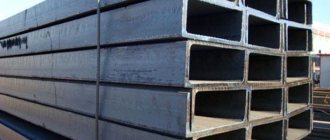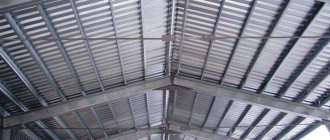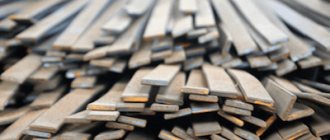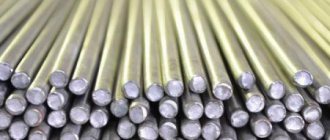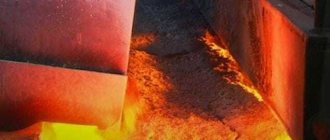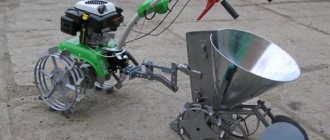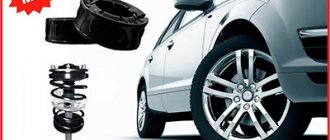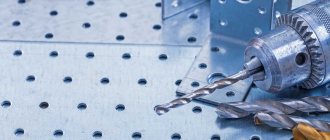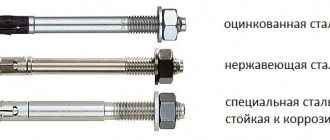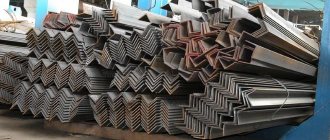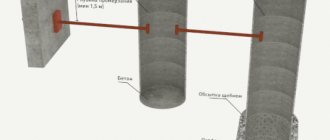The parameters of one of the most popular types of rolled metal - steel equal-flange angle - are determined by GOST 8509-93. The use of GOST in the production of such products not only unifies their types, but also improves the interaction between producers and consumers. The dimensions and weight of equal-flange steel angles, which are manufactured in full compliance with the regulatory document, make it possible to use these characteristics to accurately calculate material consumption, which is very important when carrying out construction and repair work.
How a corner is made - differences in products
Many uses have been invented for the standard L-shaped profile of a steel corner, which is understandable - the bending point is at the same time a stiffening rib and a convenient shape for laying corners on other surfaces. A popular type of rolled product is made mainly from ordinary carbon steel, less often from high-quality structural steel. Over the years, the production of steel angles has acquired many GOSTs, for example, general requirements and characteristics for the product are present in GOST 19771-93, while each type and method of rolling has its own separate GOST.
Hot rolled angle is produced by rolling a bloom (an ingot of metal) through a series of rotating shafts that apply the required pressure to the hot metal. During the movement, an L-shape without a radius on the outside is also formed. There is a radius on the inside - it plays the important role of an additional stiffener. According to GOST 8509-93, maximum deviations from the length of angles on sale should be no more than 0.75% of those declared by the manufacturer, and the curvature coefficient should be no more than 0.4% of the length.
The technology of cold-rolled production is significantly different - basically, angles are made from metal strips (ordinary steel) on roll forming machines, or strip blanks are rolled through a series of shafts. Due to their higher cost, such products are not suitable for creating load-bearing and monolithic structures; their scope of application is limited mainly to finishing work. The range is represented by products from 6 to 12 meters. Externally, it is very simple to distinguish cold-rolled products from hot-rolled ones - the former do not have the scale characteristic of the latter.
Varieties of equal-flange steel angles
Equal angle corners are divided into several categories depending on the manufacturing method and the raw materials used for their production. All geometric parameters, as well as permissible deviations for them, are regulated by two regulatory documents:
- GOST 8509-93 (production of hot-rolled equal-flange angles);
- GOST 19771-93 (production of equal-flange steel angles obtained by bending).
You can familiarize yourself with the GOST requirements and the range of hot-rolled and bent equal-flange steel angles by downloading the relevant documents in pdf format from the links below.
The difference between equal-shelf and unequal-shelf products is that the former have shelves of the same dimensions (width), while the latter have different shelves. Hot-rolled corner profiles are manufactured using the following technology: a hot billet is rolled between the shafts of a special rolling mill, where, under pressure, it is formed into a product with the required geometric shape and dimensions.
In order to produce a metal corner of the bent type, rolled sheets of the appropriate size are bent on roll forming equipment or on pipe mills. Due to the peculiarities of their production, hot-rolled profiles are characterized by higher strength, but bent corners also have their advantages: high dimensional accuracy, light weight, wide range.
The range of equal angle angles includes products from:
- high strength steel;
- alloyed, high-alloy steel;
- alloys characterized by increased heat resistance, heat resistance and corrosion resistance.
The most common material for the production of bent angles is also carbon steel, the characteristics of which must comply with GOST 380-94.
Metal corner
- /
- home
- Rolled metal
- Long products
/
/
GOST 8509-93 GOST 8510-86 GOST 19771-93 GOST 19772-93
Metal corners in the warehouse of the MetalTechService Company are presented in a wide range from stock and on order if wagon deliveries are required.
You can buy a metal corner in Yekaterinburg from the PKF MetalTechService company at a competitive price!
Calculate the quantity of corner you need and place your order.
Angle weight © metcalc.ru
Corner rentals are made from:
*carbon steel of ordinary quality (GOT 380-94) grades: St0, St3kp, St3ps, St3sp, St4kp, St4ps, St4sp, St5ps, St6ps, St6sp;
*high-strength (low-alloy) steel (GOST 19281-89) grades: 09G2, 12GS, 16GS, 14G2, 17GS, 09G2S, 14KhGS, 15KhSND, 10KHNDP, 17G1S, 10G2S1, 10G2BD 10KHSND, 14G2AF, 16G2AF, 15G2AFDps, 18G2AFps.
| Size/steel grade | st3sp/ps5 | 09G2S |
| Unequal corner | ||
| 45x28x4.0 | 34 700,00 | 37 400,00 |
| 60x40x4.0 | 32 300,00 | 33 050,00 |
| 63x40x5; 63x40x6 | 29 800,00 | 33 050,00 |
| 75x50x5; 75x50x6; 75x50x8 | 30 100,00 | 33 050,00 |
| 100x63x8; 100x63x10 | 29 800,00 | 33 050,00 |
| 125x80x8; 125x80x10 | 36 600,00 | 38 200,00 |
| 140x90x8; 140x90x10 | 36 600,00 | 38 200,00 |
| 160x100x10.0 | 33 300,00 | 41 600,00 |
| Equal angle corner | ||
| 25x25x3.0 | 29 300,00 | 30 100,00 |
| 25x25x4.0 | 27 700,00 | 30 100,00 |
| 32x32x3.0 | 29 300,00 | 30 100,00 |
| 32x32x4.0 | 27 200,00 | 30 100,00 |
| 35x35x4.0 | 27 200,00 | 30 100,00 |
| 40x40x4.0; 40x40x5.0 | 27 200,00 | 30 100,00 |
| 45x45x4; 45x45x5 | 27 800,00 | 29 600,00 |
| 50x50x4.0 | 27 800,00 | 29 600,00 |
| 50x50x5.0 | 27 200,00 | 29 600,00 |
| 50x50x6.0 | 27 700,00 | 30 100,00 |
| 63x63x4.0; 63x63x5.0; 63x63x6.0 | 27 200,00 | 30 100,00 |
| 70x70x5; 70x70x6 | 27 700,00 | 29 800,00 |
| 70x70x7; 70x70x8 | 28 500,00 | 30 100,00 |
| 75x75x5.0 | 27 500,00 | 29 800,00 |
| 75x75x6; 75x75x8 | 27 200,00 | 29 600,00 |
| 80x80x6; 80x80x8 | 27 200,00 | 29 600,00 |
| 90x90x6.0 | 27 500,00 | 29 800,00 |
| 90x90x7.0 | 27 200,00 | 29 600,00 |
| 90x90x8; 90x90x9 | 27 500,00 | 29 800,00 |
| 100x100x7; 100x100x8; 100x100x10 | 27 200,00 | 29 600,00 |
| 100x100x12.0 | 29 400,00 | 30 800,00 |
| 110x110x7; 110x110x8; 110x110x10; 110x110x12 | 29 400,00 | 32 150,00 |
| 125x125x8; 125x125x9 | 27 200,00 | 29 600,00 |
| 125x125x10; 125x125x12 | 27 500,00 | 29 800,00 |
| 140x140x9.0 | 33 000,00 | 35 700,00 |
| 140x140x10.0 | 33 000,00 | 35 300,00 |
| 160x160x10; 160x160x12; 160x160x14; 160x160x16 | 33 000,00 | 35 300,00 |
| 180x180x11; 180x180x12 | 33 000,00 | 35 300,00 |
| 200x200x12; 200x200x16; | 33 000,00 | 35 300,00 |
| 200x200x20.0 | 34 000,00 | 36 000,00 |
Application
Due to the manufacturability of its shape, good weldability, strength and resistance to various types of loads, steel angles are used almost everywhere. You can buy a steel corner corner either at metal wholesale depots in your city or on the Internet. It is used primarily in construction as one of the main elements of load-bearing, heavily loaded metal structures - floors, spans, trusses, etc.
The corner profile shape is ideal for making door and window openings. An unequal angle, which has a different moment of resistance with respect to different axes, is well suited for the manufacture of curved structures, such as arches.
Small standard sizes are used in the manufacture of furniture to strengthen its frame. Stainless steel profiles are used for interior decoration.
The corner is widely used in mechanical engineering - in the production of cars, carriages, large-sized and special equipment.
During electrical installation work, the corner profile is used as a basis for fastening equipment and cables. An angle made of low-alloy steel is used for high loads and the need to protect structures from aggressive environments and high humidity.
How to choose?
Speaking about the choice of materials for decorating slopes, it should be noted that the F-profile has received greater recognition among professionals. They have long appreciated its versatility, practicality and ease of installation.
As a rule, the choice in favor of a decorative L-profile is due to its wide variety of colors and textures on the construction market.
This type of corner is aesthetically pleasing and convenient for decorating a slope, which is why designers love to use it when creating a stylish apartment interior.
Steel angle - strictly according to GOST
Based on the cross-sectional type, products are divided into equal-flange and unequal-flange. The shelf of an angle is one of its sides, to put it in plain language. Equal-sex ones, as the name suggests, have identical shelves, which cannot be said about unequal-sex ones. The range of the latter is limited and is often made to order.
The shelf width varies from 20 mm to 200 mm, the metal thickness reaches a maximum of 16 mm. The weight of a steel angle is measured in kilograms per meter, for example, for an equal-flange product with a shelf width of 20 mm and a metal thickness of 3 mm, the weight will be 0.890 kg/m. For the largest representative of this family - a two-hundred-millimeter product - with a thickness of 12 mm, the weight will be about 37 kg/m.
According to the accuracy class, corners are divided into high-precision products, also known as class A, and ordinary accuracy, class B. Products are numbered depending on the width of the shelf, which is measured in millimeters. The standard length of products is from six to twelve meters, this is not counting the unmeasured length, the minimum value of which is 4 meters. When producing large batches of a strictly defined size, according to GOST, 15% of oversized products are allowed.
Types and symbols of steel angles
Anyone who does not delve into drawings and regulations, with a quick glance at these drawings, will notice an abundance of understandable and incomprehensible designations. It is worth noting that half of them are unlikely to be useful for folk art.
But we should definitely sort out the “necessary” ones. So, look at Figure 1:
- b – shelf width;
- t – flange thickness;
- r – outer radius;
- R – inner radius.
and unequal according to GOST 8510-93 (Figure 2).
Let's look at Figure 2 in the same way. There we see the already familiar symbols, only with a slight addition of the size of the larger shelf.
- B – width of the larger shelf;
- b – width of the smaller shelf;
- t – flange thickness;
- r – outer radius;
- R – inner radius.
That's probably all that is important to know for simple creativity. The remaining designations are needed for engineering calculations; they will be given below in the tables, and those who know the secrets of strength of materials will understand all sorts of axes, moments and resistances themselves.
But how Gost marking is implemented in practice can be seen in a specific example from the products we offer. Let's look at everyone's favorite 50th corner.
50x50x4 09G2S . The corner has two equal shelves (equal flange) of 50 mm (dimension b ), wall thickness t=4 mm , made of low-alloy structural steel 09G2S in accordance with GOST 8509-93 .
Next we can check Table 1 ( see below
) and find out another practical value -
the mass of one meter of the product.
For our example, it will be 3.05 kg . Resp. for a corner 50x50x5 the theoretical weight is 3.77 kg
How to choose steel angles?
So, how should you choose the right metal corners?
The first is accuracy. You can recognize it by the letter in the marking. If there is a letter A, then this means that the corner has high accuracy. If Latin B is indicated, this means that this product has normal accuracy.
What can this parameter actually affect? It shows the parameters of the finished product (evenness, accuracy, thickness, as well as any deviations).
For small rolled metal products, high accuracy is an important characteristic. But for large products, completely different characteristics are important.
The second is the manufacturing methods. There are two types of manufacturing - cold rolling and hot rolling. That is, during hot production, products are rolled in special forms through hot machines (or the finished product is bent).
If we compare a cold-rolled product with a hot-rolled one, the former have low strength. Therefore, if high strength is required, then this steel angle will not work; it is better not to purchase it.
The third thing to pay attention to is the shelves. There are two types - equilateral and non-equilateral. Option No1 is a metal strip that has an angle of 90% in the middle. The second No2 resembles the letter G because one side is longer than the other.
Corners that have equal sides are stronger, so they are used more often. But if it is necessary to individually calculate the length of both shelves, then non-equilateral corners are used here. This option also has high reinforcing properties.
And fourth is the steel from which the corners are made. In the manufacture of metal corners, more than one type of steel is used. If ordinary steel was used in the manufacture of the corner, then its price will be lower.
If in construction it is necessary for the structure to be reliable, so that it is not affected by the environment and temperature changes, then you should opt for products made of low-alloy steel.
Properties and chemical composition of low-alloy steels
Low-alloy alloys are highly ductile, highly weldable, and do not become brittle under certain circumstances. They obtain the highest strength and mechanical characteristics after a hardening or normalization process followed by tempering at high temperatures. Examples of grades of low-alloy alloys are the following designations : 15ГС, 14Г2, 14ХГС , as well as others.
They have a small percentage of carbon content, up to 18%. High strength characteristics are ensured by the use of other alloyed additives, such as silicon, nickel, chromium and others. Low-alloy steel can be welded well, is not brittle, and has high impact resistance. But such alloys do not withstand concentration and long-term stress; destruction occurs from prolonged exposure to vibrations.
Weight value per linear meter of angle
This characteristic is very important for calculating the mass of structures. The value allows you to convert the footage of the required amount of equal flange hot-rolled angle into a weight category. Such data allows you to choose the correct shipping method, calculate the required transport productivity, and make calculation comparisons to select foundation designs and foundations.
To determine the weight of the required batch of angles according to the assortment, find out the weight of one linear meter of rolled steel, taking into account the width of the shelf and the thickness of the metal wall. The theoretical weight value is multiplied by the number of meters of the corner and the calculated weight is obtained.
The actual weight of the calculated batch differs slightly from the obtained value, which is typical due to the difference in the density of the alloy grade used in a particular case and the accuracy class in the manufacture of the angle. For convenience, at the end of the table the number of linear meters of angle contained in one ton of rolled products is shown.
The assortment contains reference information about the radii of curvature, the distance from the edge of the flange to the calculated center of gravity, the cross-sectional area of the corner in the section, the value of the radius of inertia and the moment of centrifugal inertia are indicated. All these parameters are used in various calculations, for example, when determining the resulting strength of a structure from a corner. Some of the reference indicators are needed to adjust the rollers of the rolling mill during production.
The use of hot-rolled angle is determined by the technical characteristics of the steel that was used for the manufacture of long products. Different types of structures require a certain type of indicators, which allows the use of corners without overestimating the strength indicators, and without spending extra money. Due to this diversity, the equal-flange angle is used in the construction of any frame and other metal structures and for the reinforcement of monolithic structures .
The disadvantage of steel corners is their low resistance to corrosion in wet conditions, therefore, in critical structures, metal corners are replaced with products made of galvanized steel, stainless steel or aluminum.
Types of metal corners
Hot rolled. It is made from a finished steel billet, which is heated and passed through a machine. And according to the dimensions that are given, the product is formed.
Bent. This type is made from a strip of steel; it can be used either cold or hot rolling, during which a bend is formed. This corner will suit any design idea.
Equal. The name speaks for itself. All sides of this angle are equal.
Unequal. This corner has different side sizes.
The metal corner has standard dimensions:
- 20x20 mm;
- 25x25mm;
- 50x50mm;
- 70x70mm;
- 75x75mm;
- 100x100mm;
- 120x120mm;
- 150x150mm;
- 200x200mm.
You can also classify metal corners by length. There are two types. This:
- Measured;
- Unmeasured.
The lengths of measuring metal corners are 6,7,9,10,11 and 12 mm. The price of this product varies not by unit, but by weight category. That is, the buyer will pay not for the quantity of products, but for its weight.
Unmeasured metal corners can have different lengths. Typically it varies from 4 to 12 mm.
Application areas of metal corners
- In homestead construction. Angular steel is used for the construction of large-sized greenhouses and small greenhouses, fences with chain-link mesh, portable and stationary gazebos.
- When constructing stairs - internal and external. The corner can be used for the manufacture of such metal products as step frames, porch platform frames, porch supports, stair railings.
- For strengthening window and door openings in brick or block masonry. The use of steel corner bars prevents the appearance of cracks in the wall and thereby extends the service life of the entire building.
- Production of canopies, street structures (benches, tables, swings), frames for bars on doors and windows, wickets, gates.
- Manufacturing of shelving in warehouses and in production , cabinet frames, trolleys, workbenches, various production equipment - testing and assembly stands.
- In everyday life - frames of metal doors, household brick stoves.
The widespread use of metal angles in construction provides the following advantages of rolled steel: a combination of strength and low weight, ease of transportation, storage and installation, durability subject to anti-corrosion treatment.
Size tables. Weight 1 meter
Table 1. Equal flange hot-rolled angle GOST 8509-93 .
| Corner number | mm | Cross-sectional area cm2 | Reference values for axes | Macca 1m corner, kg | ||||||||||||||
| b | t | R | r | x - x | x0-x0 | U0-U0 | Jxy, cm4 | Y0, cm | ||||||||||
| Jx, cm4 | Ix, cm3 | ix, cm | Jy0min, cm4 | ix0max, cm | Jy0min, cm | Wy0, cm3 | iy0min, cm | |||||||||||
| 2 | 20 | 3 4 | 3,5 | 1,2 | 1,13 1,46 | 0,40 0,50 | 0,28 0,37 | 0,59 0,58 | 0.6З 0.78 | 0,75 0,73 | 0,17 0,22 | 0,20 0,24 | 0,39 0,38 | 0,23 0,28 | 0,60 0,64 | 0,89 1,15 | ||
| 2,5 | 25 | 3 4 5* | 1,43 1,86 2,27 | 0,81 1,03 1,22 | 0,46 0,59 0,71 | 0,75 0,71 0,73 | 1,29 1,62 1,91 | 0,95 0,93 0,92 | 0,34 0,44 0,53 | 0,33 0,41 0,47 | 0,49 0,48 0,48 | 0,47 0,59 0,69 | 0,73 0,76 0,80 | 1,27 1,46 1,78 | ||||
| 2,8 | 28 | 3 | 4,0 | 1,3 | 1,62 | 1,16 | 0,58 | 0,85 | 1,84 | 1,07 | 0,48 | 0,42 | 0,55 | 0,68 | 0,80 | 1,27 | ||
| 3 | 30 | 3 4 5* | 4,0 | 1,3 | 1,74 2,27 2,78 | 1,45 1,84 2,20 | 0,67 0,87 1,06 | 0,91 0,80 0,89 | 2,30 2,92 3,47 | 1.15 1.1З 1.12 | 0,60 0,77 0,94 | 0,53 0,61 0,71 | 0,59 0,58 0,58 | 0,85 1,08 1,27 | 0,85 0,89 0,93 | 1,36 1,78 2,18 | ||
| 3,2 | 32 | 3 | 4,5 | 1,5 | 1,36 2,43 | 1,77 2,26 | 0,77 1,0 | 0,97 0,96 | 2,80 3,58 | 1,23 1,21 | 0,74 0,94 | 0,59 0,71 | 0,63 0,62 | 1,03 1,32 | 0,89 0,94 | 1,46 1,91 | ||
| 4 | ||||||||||||||||||
| 3,5 | 35 | 3 | 2,04 2,17 3,28 | 2,35 3,01 3,61 | 0,93 1,21 1,47 | 1,07 1,06 1,05 | 3,72 4,76 5,71 | 1,35 1,33 1,32 | 0,97 1,25 1.52 | 0,71 0,88 1,02 | 0,69 0,68 0,68 | 1,37 1,75 2,10 | 0,97 1,01 1,05 | 1.60 2,10 2,58 | ||||
| 4 | ||||||||||||||||||
| 5 | ||||||||||||||||||
| 4 | 40 | 3 4 5 b* | 5,0 | 1,7 | 2,35 3,08 3,79 4,48 | 3,55 4,58 5.53 6,41 | 1,22 1,60 1,95 2,30 | 1.23 1,22 1,21 1,20 | 5,63 7,26 8,75 10,13 | 1,55 1,53 1,52 1.50 | 1,47 1,90 2,30 2,70 | 0,95 1,19 1,39 1,58 | 0,79 0,78 0,78 0,78 | 2,08 2,68 3,22 3,72 | 1,09 1,13 1,17 1,21 | 1,85 2,42 2,98 3,52 | ||
| 4,5 | 45 | 3 4 5 6* | 2,65 3,48 4,29 5,08 | 5,13 6,63 8,03 9,35 | 1,56 2,04 2,51 2,95 | 1,39 1,38 1,37 1,36 | 8,13 10,52 12,74 14,80 | 1,75 1,74 1,72 1,71 | 2,12 2,74 3,33 3,90 | 1,24 1,54 1,81 2.06 | 0,89 0,89 0,88 0,88 | 3,00 3,89 4,71 5,45 | 1,21 1,26 1,30 1,34 | 2,08 2,73 3,37 3,99 | ||||
| 5 | 50 | 3 4 5 6 7* 8* | 5,5 | 1,8 | 2,96 3,89 4,80 5,69 6,56 7,41 | 7,11 9,21 11,20 13,07 14.84 16,51 | 1,94 2,54 3,13 3,69 4,23 4,76 | 1,55 1,54 1,53 1,52 1,50 1,49 | 11,27 14,63 17,77 20,72 23.47 26,03 | 1,95 1,94 1,92 1,91 1,89 1,87 | 2,95 3,80 4,63 5,43 6,21 6,98 | 1,57 1,95 2,30 2,63 2,93 3,22 | 1,00 0,99 0,98 0,98 0.97 0,97 | 4,16 5,42 6,57 7,65 8,63 9,52 | 1,33 1,38 1,42 1,46 1,50 1,53 | 2,32 3,05 3,77 4,47 5,15 5,82 | ||
| 5,6 | 56 | 4 5 | 6,0 | 2,0 | 4,38 5,41 | 13,10 15,97 | 3,21 3,96 | 1,73 1,72 | 20.79 25,36 | 2,18 2,16 | 5,41 6,59 | 2,52 2,97 | 1,11 1,10 | 7,69 9,41 | 1,52 3,57 | 3,44 4,25 | ||
| 6* | 60 | 4 | 7,0 | 2,3 | 4,72 | 16,21 | 3,70 | 1,85 | 25,69 | 2,33 | 6,72 | 2,93 | 1,19 | 9.4S | 1,62 | 3,71 | ||
| 5 | 5,83 | 19,79 | 4,56 | 1,84 | 31,40 | 2,32 | 8,18 | 3,49 | 1,18 | 11,61 | 1,66 | 4,58 | ||||||
| 6 | 6,92 | 23,21 | 5,40 | 1,83 | 36,81 | 2,31 | 9,60 | 3,99 | 1,18 | 13,60 | 1,70 | 5,43 | ||||||
| 8 | 9,04 | 29,55 | 7,00 | 1,81 | 46,77 | 2,27 | 12,34 | 4,90 | 1,17 | 17,22 | 1,78 | 7,10 | ||||||
| 10 | 11,08 | 35,32 | 8,52 | 1,79 | 55,64 | 2,24 | 15,00 | 5,70 | 1,16 | 20,32 | 1,85 | 8,70 | ||||||
| 6,3 | 63 | 4 | 4,96 | 18,86 | 4,09 | 1,95 | 29,90 | 2,45 | 7,81 | 3,26 | 1,25 | 11,00 | 1,69 | 3,90 | ||||
| 5 | 6,13 | 23,10 | 5,05 | 1,94 | 36.8O | 2,44 | 9,52 | 3,87 | 1,25 | 13,70 | 1,74 | 4,81 | ||||||
| 6 | 7,28 | 27,06 | 5,98 | 1,93 | 42,91 | 2,43 | 11,18 | 4,44 | 1,24 | 15,90 | 1,78 | 5,72 | ||||||
| 7 | 70 | 4,5 | 8,0 | 2,7 | 6,20 | 29,04 | 5,67 | 2,16 | 46,03 | 2,72 | 12,04 | 4,53 | 1,39 | 17,00 | 1.8S | 4,87 | ||
| 5 | 6,86 | 31,94 | 6,27 | 2,16 | 50,67 | 2,72 | 13,22 | 4,92 | 1,39 | 18,70 | 1,90 | 5,38 | ||||||
| 6 | 8,15 | 37,58 | 7,43 | 2,15 | 59,64 | 2,71 | 15,52 | 5,66 | 1,38 | 22,10 | 1,94 | 6,39 | ||||||
| 7 | 9,42 | 42.98 | 8,57 | 2.14 | 68,19 | 2,69 | 17,77 | 6,31 | 1,37 | 25,20 | 1,99 | 7,39 | ||||||
| 8 | 10,67 | 48,16 | 9,68 | 2,12 | 76,35 | 2,68 | 19,97 | 6,99 | 1,37 | 28,20 | 2,02 | 8,37 | ||||||
| 10* | 13,11 | 57,90 | 11,82 | 2,10 | 91,52 | 2,64 | 24,27 | 8,17 | 1,36 | 33,60 | 2,10 | 10,29 | ||||||
| 7,5 | 75 | 5 | 9,0 | 3,0 | 7,39 | 39,53 | 7,21 | 2,31 | 62,65 | 2,91 | 16,41 | 5,74 | 1,49 | 23,10 | 2,02 | 5,80 | ||
| 6 | 8,78 | 46,57 | 8,57 | 2,30 | 73,87 | 2,90 | 19,28 | 6,62 | 1,48 | 27,30 | 2,06 | 6,89 | ||||||
| 7 | 10,15 | 53,34 | 9,89 | 2,29 | 84,61 | 2,89 | 22,07 | 7,43 | 1,47 | 31,20 | 2,10 | 7,96 | ||||||
| S | 11,50 | 59,84 | 11,18 | 2,28 | 94,89 | 2,87 | 24,80 | 8,16 | 1,47 | 35,00 | 2,15 | 9,02 | ||||||
| 9 | 12,83 | 66,10 | 12,43 | 2,27 | 104,72 | 2,86 | 27,48 | 8,91 | 1,46 | 38,60 | 2,18 | 10,07 | ||||||
| 8 | 80 | 5,5 | 9,0 | 3,0 | 8,63 | 52,68 | 9,03 | 2,47 | 83,56 | 3,11 | 21,80 | 7,10 | 1,59 | 30,90 | 2,17 | 6,78 | ||
| 6 | 9,38 | 56,97 | 9,ao | 2,47 | .90,40 | 3,11 | 23,54 | 7,60 | 1,58 | 33,40 | 2,19 | 7,36 | ||||||
| 7 | 10,85 | 65,31 | 11,32 | 2,45 | 103,60 | 3,09 | 26,97 | 8,55 | 1,58 | 38,30 | 2,23 | 8,51 | ||||||
| & | 12,30 | 73,36 | 12,80 | 2,44 | 116,39 | 3,08 | 30,32 | 9,44 | 1,57 | 43,00 | 2,27 | 9,65 | ||||||
| 10* | 15,14 | 83,58 | 15,67 | 2,42 | 140,31 | 3,04 | 36,85 | 11,09 | 1,56 | 56,70 | 2,35 | 11,88 | ||||||
| 12* | 17,90 | 102,74 | 18,42 | 2,40 | 162,27 | 3,01 | 43,21 | 12,62 | 1,55 | 59,50 | 2,42 | 14,05 | ||||||
| 9 | 90 | 6 | 10,0 | 3,3 | 10,61 | 82,10 | 12,49 | 2,78 | 130,00 | 3,50 | 33,97 | 9,88 | 1,79 | 48,10 | 2,43 | 8,33 | ||
| 7 | 12,28 | 94,30 | 14,45 | 2,77 | 149,67 | 3,49 | 38,94 | 11,15 | 1,78 | 55,40 | 2,47 | 9,64 | ||||||
| 8 | 13,93 | 106,11 | 16,36 | 2,76 | 168,42 | 3,48 | 43,80 | 12,34 | 1,77 | 62,30 | 2,51 | 10,93 | ||||||
| 9 | 15,60 | 118,00 | 18,29 | 2,75 | 186,00 | 3,46 | 48,60 | 13,48 | 1,77 | 68,00 | 2,55 | 12,20 | ||||||
| 10* | 17,17 | 128,66 | 20,07 | 2,74 | 203,93 | 3,45 | 53,27 | 14,54 | 1,76 | 75,30 | 2,59 | 13,48 | ||||||
| 12* | 20,33 | 149,67 | 23,85 | 2,71 | 235,88 | 3,41 | 62,40 | 16,53 | 1,75 | 86,20 | 2,67 | 15,96 | ||||||
| 10 | 100 | 6 | 12,0 | 4,0 | 12,82 | 122,10 | 16,69 | 3,09 | 193,46 | 3,89 | 50,73 | 13,38 | 1,99 | 71,40 | 2,68 | 10,06 | ||
| 7 | 13,75 | 130,59 | 17,90 | 3,08 | 207,01 | 3,88 | 54,16 | 14,13 | 1,98 | 76,40 | 2,71 | 10,79 | ||||||
| 8 | 15,60 | 147,19 | 20,30 | 3,07 | 233,46 | 3,87 | 60,92 | 15,66 | 1,98 | 86,30 | 2,75 | 12,25 | ||||||
| 10 | 19,24 | 178,95 | 24,97 | 3,05 | 283,83 | 3,84 | 74,08 | 18,51 | 1,96 | 110,00 | 2,83 | 15,10 | ||||||
| 12 | 22,80 | 208,90, | 29,47 | 3,03 | 330,95 | 3,81 | 86,84 | 21,10 | 1,95 | 122,00 | 2,91 | 17,90 | ||||||
| 14 | 26,28 | 237,15 | 33,83 | 3,00 | 374,98 | 3,78 | 99,32 | 23,49 | 1,94 | 138,00 | 2,99 | 20,63 | ||||||
| 15* | 27.99 | 250,68 | 35,95 | 2,99 | 395,87 | 3,76 | 105,48 | 24,62 | 1,94 | 145,00 | 3,03 | 21,37 | ||||||
| 16 | 29,68 | 263,82 | 38,04 | 2,98 | 416,04 | 3,74 | 111,61 | 25,79 | 1,94 | 152,00 | 3,06 | 23,30 | ||||||
| 11 | 110 | 7 | 15,15 | 175,61 | 21,83 | 3,40 | 278,54 | 4,29 | 72,68 | 17,36 | 2,19 | 106,00, | 2,96 | 11,89 | ||||
| 8 | 17,20 | 198D7 | 24,77 | 3,39 | 314,51 | 4,28 | 81,83 | 19,29 | 2,18 | 116,00 | 3,00 | 13,50 | ||||||
| 12 | 120 | 8 | 12,0 | 4,0 | 18,80 | 259,75 | 29,68 | 3,72 | 412,45 | 4,68 | 107,04 | 23,29 | 2,39 | 153,00 | 3,25 | 14,76 | ||
| 10 | 23,24 | 317,16 | 36,59 | 3,69 | 503,79 | 4,66 | 130,54 | 27,72 | 2,37 | 187,00 | 3,33 | 18,24 | ||||||
| 12 | 27,60 | 371,80 | 43,30 | 3,67 | 590,28 | 4,62 | 153,33 | 31,79 | 2,36 | 218,00 | 3;41 | 21,67 | ||||||
| 15 | 33,99 | 448,90 | 52,96 | 3,63 | 711,32 | 4,57 | 186,48 | 37,35 | 2,34 | 262,00 | 3,53 | 26.68 | ||||||
| 12,5 | 125 | 8 | 14,0 | 4,6 | 19,69 | 294,36 | for, 20 | 3,87 | 466,76 | 4,87 | 121,98 | 25,67 | 2,49 | 172,00 | 3,36 | 15,46 | ||
| 9 | 22,0 | 327,48 | 36,00 | 3,86 | 520,00 | 4,86 | 135,58 | 28,26 | 2,48 | 192,00 | 3,40 | 17,30 | ||||||
| 10 | 24,33 | 359,82 | 39,74 | 3,85 | 571,04 | 4,84 | 148,59 | 30,45 | 2,47 | 211,00 | 3,45 | 19,10 | ||||||
| 12 | 2M9 | 422,23 | 47,06 | 3,82 | 670,02 | 4,82 | 174,43 | 34,94 | 2,46 | 248,00 | 3,53 | 22,68 | ||||||
| 14 | 33>37 | 481,76 | 54,17 | 3,80 | 76190 | 4,78 | 199,62 | 39,10 | 2,45 | 232,00 | 3,61 | 26,20 | ||||||
| 16 | 37,77 | 538,56 | 61,09 | 3,78 | 852,84 | 4,75 | 224,29 | 43,10 | 2,44 | 315,00 | 3,68 | 29,65 | ||||||
| 14 | 140 | 9 | 14,0 | 4,6 | 24,72 | 405,72 | 45,55 | 4,34 | 739,42 | 5,47 | 192,03 | 35,92 | 2,79 | 274,00 | 3,76 | 19,41 | ||
| 10 | 27,33 | 512,29 | 50,32 | 4,33 | 813,62 | 5,46 | 210,96 | 39,05 | 2,78 | 301,00 | 3,82 | 21,45 | ||||||
| 12 | 32,49 | 602,43 | 59,66 | 4,31 | 956,98 | 5,43 | 248,01 | 44,97 | 2,76 | 354,00 | 3,90 | 25,50 | ||||||
| Angles marked with an asterisk are manufactured according to customer requirements. GOST 8509-93 provides profile numbers; 16, 18, 20, 22 and 25, as well as profiles manufactured by agreement between manufacturers and consumers. The cross-sectional area and reference values are calculated based on the nominal dimensions. Steel density 7.85 g/cm3. | ||||||||||||||||||
Table 2. Metal unequal angle GOST 8510-93 .
| Size, mm | Weight 1 m, kg | Meters per ton | ||
| B | b | t | ||
| 25 | 16 | 3,0 | 0,91 | 1098,90 |
| 32 | 20 | 3,0 | 1,17 | 854,70 |
| 4,0 | 1,52 | 657,89 | ||
| 40 | 25 | 3,0 | 1,48 | 675,68 |
| 4,0 | 1,94 | 515,46 | ||
| 5,0 | 2,37 | 421,94 | ||
| 45 | 28 | 3,0 | 1,68 | 595,24 |
| 4,0 | 2,20 | 454,55 | ||
| 50 | 32 | 3,0 | 1,90 | 526,32 |
| 4,0 | 2,40 | 416,67 | ||
| 56 | 36 | 4,0 | 2,81 | 355,87 |
| 5,0 | 3,46 | 289,02 | ||
| 63 | 40 | 4,0 | 3,17 | 315,46 |
| 5,0 | 3,91 | 255,75 | ||
| 6,0 | 4,63 | 215,98 | ||
| 8,0 | 6,03 | 165,84 | ||
| 75 | 50 | 5,0 | 4,79 | 208,77 |
| 6,0 | 5,69 | 175,75 | ||
| 8,0 | 7,43 | 134,59 | ||
| 90 | 56 | 6,0 | 6,70 | 149,25 |
| 100 | 63 | 6,0 | 7,53 | 132,80 |
| 7,0 | 8,70 | 114,94 | ||
| 8,0 | 9,87 | 101,32 | ||
| 10,0 | 12,14 | 82,37 | ||
| 110 | 70 | 6,5 | 8,98 | 111,36 |
| 8,0 | 10,93 | 91,49 | ||
| 125 | 80 | 8,0 | 12,58 | 79,49 |
| 10,0 | 15,47 | 64,64 | ||
| 12,0 | 18,34 | 54,53 | ||
| 140 | 90 | 8,0 | 14,13 | 70,77 |
| 10,0 | 17,46 | 57,27 | ||
| 160 | 100 | 9,0 | 17,96 | 55,68 |
| 10,0 | 19,85 | 50,38 | ||
| 12,0 | 23,58 | 42,41 | ||
| 14,0 | 27,26 | 36,68 | ||
| 180 | 110 | 10,0 | 22,20 | 45,05 |
| 12,0 | 26,40 | 37,88 | ||
| 200 | 125 | 12,0 | 29,74 | 33,62 |
| 14,0 | 34,43 | 29,04 | ||
| 16,0 | 39,07 | 25,60 | ||
Equal and unequal angles are: hot rolled ( GOST 8510-86 and GOST 8509-93 ) and bent ( GOST 19771-93 and GOST 19772-93 ). The former are stronger and are used in structures designed for increased loads. Bent angles are produced from rolled sheets using roll forming units.
Table 3. Equal-flange bent angle GOST 19771-93 . Dimensions and weight of angles made of carbon boiling and semi-calm steel of ordinary quality, high-quality carbon steel with a tensile strength of no more than 460 N/mm2
| b, mm | S, mm | R, no more, mm | Weight 1 m, kg | Number of meters 1 t |
| 36 | 3 | 4 | 1,569 | 637,2 |
| 40 | 2,5 | 3 | 1,485 | 673,3 |
| 40 | 3 | 4 | 1,758 | 568,9 |
| 50 | 3 | 4 | 2,229 | 448,7 |
| 50 | 4 | 6 | 2,907 | 344,0 |
| 60 | 3 | 4 | 2,700 | 370,4 |
| 60 | 4 | 6 | 3,535 | 282,9 |
| 70 | 4 | 6 | 4,163 | 240,2 |
| 80 | 3 | 4 | 3,642 | 274,6 |
| 80 | 4 | 6 | 4,791 | 208,7 |
| 80 | 5 | 7 | 5,924 | 168,8 |
| 80 | 6 | 9 | 7,011 | 142,6 |
| 80 | 7 | 9 | 8,113 | 123,3 |
| 100 | 4 | 6 | 6,047 | 165,4 |
| 100 | 5 | 7 | 7,494 | 133,4 |
| 100 | 6 | 9 | 8,895 | 112,4 |
| 100 | 7 | 9 | 10,31 | 96,99 |
| 120 | 5 | 7 | 9,064 | 110,3 |
| 120 | 6 | 9 | 10,78 | 92,77 |
Table 4. Unequal bent angle GOST 19772-93 . Dimensions and weight of angles made of carbon boiling and semi-calm steel of ordinary quality, high-quality carbon steel with a tensile strength of no more than 460 N/mm2
| B, mm | b, mm | S, mm | R, no more, mm | Weight 1 m, kg | Number of meters in 1 ton |
| 32 | 25 | 2 | 3 | 0.3 365 | 1195 |
| 32 | 25 | 2,5 | 3 | 1,034 | 967,3 |
| 50 | 35 | 3,2 | 5 | 1,934 | 504,1 |
| 60 | 40 | 3 | 4 | 2,229 | 448,7 |
| 70 | 50 | 4 | 6 | 3,535 | 232,9 |
| 30 | 63 | 4 | 6 | 4,257 | 234,9 |
| 35 | 35 | 4 | 6 | 3,535 | 232,9 |
| 90 | 70 | 4 | 6 | 4,791 | 208,7 |
| 100 | 65 | 4 | 6 | 4,943 | 202,1 |
| 105 | 100 | 3 | 4 | 4,702 | 212,7 |
| 115 | 65 | 5 | 7 | 6,709 | 149,1 |
| 120 | 100 | 8 | 12 | 12,33 | 77,63 |
| 100 | 140 | 6 | 9 | 14,55 | 68,74 |
Table 5. Unequal bent corner. Dimensions and weight of angles made of carbon semi-quiet and calm steel of ordinary quality, high-quality carbon steel with a tensile strength of more than 460 N/mm2 and low-alloy
| B, mm | b, mm | S, MM | R, no more, mm | Weight 1 m, kg | Number of meters in 1 ton |
| 40 | 25 | 2,5 | 6 | 1,165 | 858,0 |
| 70 | 50 | 4 | 10 | 3,481 | 237,3 |
| 35 | 67 | 4 | 10 | 4,485 | 222,9 |
| 90 | 70 | 4 | 10 | 4,737 | 211,1 |
| 110 | 90 | 5 | 10 | 7,443 | 134,4 |
| 115 | 65 | 5 | 10 | 6,653 | 150,2 |
| 147 | 125 | 8 | 20 | 15,93 | 62,77 |
| 152 | 100 | 5,5 | 12 | 10,37 | 96,44 |
| 155 | 100 | 6 | 14 | 11,38 | 87,34 |
At metallurgical enterprises, angles produced in accordance with GOST 8509-93 and GOST 8510-93 are obtained by plastic deformation of a heated steel billet (bloom). The rolled product range is formed in strict accordance with the established range of standard sizes, taking into account permissible deviations and accuracy classes.
Thus, the curvature coefficient for hot-rolled angle steel is set to no more than 0.4% , and the linear error in the length of the product is no more than 0.75% .
At the same time, accuracy classes are distinguished: “ A ” - high, “ B ” - increased and “ C ” - normal.
When developing various designs, not only at the professional level, but also for private use, it is also important to take into account the steel grade of the product, as well as the tempering dimension of the angle. Its implementation is carried out in measured and multiples of measured lengths, that is, from 4 m to 12 m or unmeasured. There may be trimmings and substandard ones, which can be purchased at reduced prices.
Assortment of hot rolled angles
The high strength of these products ensures their use in creating structures that operate under severe loads. The range of equal flange hot-rolled angles is regulated by GOST 8509-93. The standard provides for two classes of rolling accuracy:
- A – increased;
- B – ordinary.
In the production of angle steel, carbon steel of ordinary quality and high-quality structural steel are used. For the manufacture of critical structures and elements of machines and mechanisms, angles made of low-alloy steels of type 09G2S, 10HSND are used. Such products can be used in a wide temperature range (-70...+450°C), therefore they are in demand in regions with harsh climates.
Table of dimensions and weight of the most common range of steel equal-flange angles according to GOST 8509-93
| Shelf width, mm | Shelf thickness, mm | Weight of 1 meter, kg | Shelf width, mm | Shelf thickness, mm | Weight of 1 meter, kg |
| 20 | 3 | 0,89 | 63 | 4 | 3,9 |
| 4 | 1,15 | 5 | 4,81 | ||
| 25 | 3 | 1,12 | 6 | 5,72 | |
| 4 | 1,46 | 70 | 5 | 5,38 | |
| 30 | 3 | 1,36 | 6 | 6,39 | |
| 4 | 1,78 | 7 | 7,39 | ||
| 35 | 3 | 1,6 | 75 | 5 | 5,8 |
| 4 | 2,1 | 6 | 6,89 | ||
| 5 | 2,58 | 7 | 7,96 | ||
| 40 | 3 | 1,85 | 8 | 9,02 | |
| 4 | 2,42 | 80 | 6 | 7,36 | |
| 5 | 2,98 | 7 | 8,51 | ||
| 45 | 3 | 2,08 | 8 | 9,65 | |
| 4 | 2,73 | 90 | 7 | 9,64 | |
| 5 | 3,37 | 8 | 10,93 | ||
| 50 | 3 | 2,32 | 9 | 12,2 | |
| 4 | 3,05 | 100 | 7 | 10,79 | |
| 5 | 3,77 | 8 | 12,25 | ||
| 6 | 4,47 | 10 | 15,1 |
